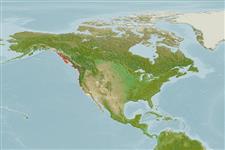Common names from other countries
>
Perciformes/Zoarcoidei (Eelpouts and pricklebacks) >
Pholidae (Gunnels) > Apodichthyinae
Etymology: Apodichthys: Greek, apodos = without feet + Greek, ichthys = fish (Ref. 45335).
More on author: Girard.
Environment: milieu / climate zone / depth range / distribution range
Ecologia
marinhas demersal; intervalo de profundidade 0 - 8 m (Ref. 96339). Temperate; 59°N - 33°N, 155°W - 118°W
Eastern Pacific: Kodiak Island, Alaska to Santa Barbara Island, southern California, USA.
Tamanho / Peso / Idade
Maturity: Lm ? range ? - ? cm
Max length : 46.0 cm TL macho/indeterminado; (Ref. 2850)
Descrição suscinta
Chaves de identificação | Morfologia | Morfometria
Espinhos dorsais (total) : 40 - 44; Raios dorsais (total) : 0; Espinhos anais: 1; Raios anais : 38 - 42. Caudal rounded, somewhat elevated dorsally; pectorals small and rounded (Ref. 6885). Color variable- from green through brown to red; dark dots spaced in a broken line along midside of body, sometimes also light spots; narrow dark line down and back from eye to operculum, sometimes through eye; some fresh specimens with a silvery line margined with orange and black from middle of maxillary through lower part of eye to nape and opercle (Ref. 6885).
Facultative air-breathing in the genus (Ref. 126274); Found in intertidal areas, especially in tide pools (Ref. 2850). May remain out of the water under rocks or seaweeds (Ref. 31184). Feeds on small crustaceans and mollusks (Ref. 6885). Pairs are found coiled around egg masses (Ref. 4925). Breathes air when out of water (Ref. 31184).
Ciclo de vida ou comportamento de acasalamento
Maturities | Reprodução | Spawnings | Egg(s) | Fecundities | Larvas
Oviparous (Ref. 101786). Adhesive eggs attached to a nest substrate are brooded by both parents (Ref. 101786).
Eschmeyer, W.N., E.S. Herald and H. Hammann, 1983. A field guide to Pacific coast fishes of North America. Boston (MA, USA): Houghton Mifflin Company. xii+336 p. (Ref. 2850)
Status na Lista Vermelha da UICN (Ref. 130435)
CITES (Ref. 128078)
Not Evaluated
Ameaça para os humanos
Harmless
Uso pelos humanos
Pescarias: espécies comerciais; Aquário: Aquários públicos
Ferramentas
Relatórios especiais
Baixar XML
Fontes da internet
Estimates based on models
Preferred temperature (Ref.
115969): 8.8 - 12.8, mean 10 (based on 180 cells).
Índice de diversidade filogenética (Ref.
82804): PD
50 = 0.7500 [Uniqueness, from 0.5 = low to 2.0 = high].
Bayesian length-weight: a=0.00102 (0.00046 - 0.00225), b=3.06 (2.88 - 3.24), in cm Total Length, based on all LWR estimates for this body shape (Ref.
93245).
Nível Trófico (Ref.
69278): 3.6 ±0.50 se; based on food items.
Resiliência (Ref.
120179): médio(a), tempo mínimo de duplicação da população 1,4 - 4,4 anos (Preliminary K or Fecundity.).
Fishing Vulnerability (Ref.
59153): Moderate vulnerability (36 of 100).
